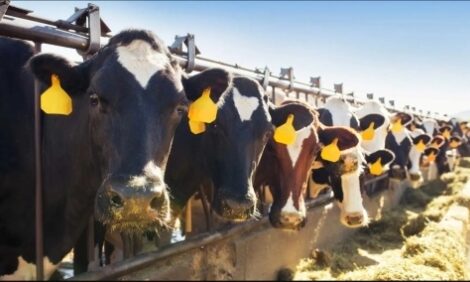



Mixed Fortunes of the French Industry on Show
A report from SPACE 2009 on the highs and lows of France's livestock sectors by Stuart Lumb for TheCattleSite.Rennes in Brittany is the venue for the French livestock's industry showcase event, SPACE. Whilst many similar events are moving to a two-year cycle, SPACE is one of the few that is held annually. This is, no doubt, helped by the fact that the French dairy industry holds its breed championships there, with cows being proudly paraded around a huge ring and with the activities visible on large video screens placed around the judging area. Another event bucking the trend though is VIV China. This trade fair is also now being held annually, reflecting the growing importance of the Chinese livestock industry. Show organisers worldwide put a great deal of emphasis on visitor numbers coming through the gates, although with today's farmers running a much larger business than, say, 10 years ago and with greater buying power, simple head-counts are less relevant than they were.
Dairy Industry in Crisis
French dairy farmers are like many of their counterparts in Europe: they are very disgruntled about the state of their industry. Currently, the milk price stands at the equivalent of £0.27 per litre, and around 10 to 15 per cent of producers are participating in a 'milk strike' at the time of the show.
SPACE was opened by the French Minister of Agriculture and he needed a substantial police escort to protect him from the attention of a group of angry dairymen. The number of dairy farmers is forecast to drop by 70 per cent by 2015, coupled with an increase in the number of cow per farm as the industry moves away from the traditional family unit.
Not surprisingly, many of the SPACE exhibitors featured labour-saving equipment such as milking robots. Ley featured its prize-winning robotic brush, which sweeps up roughage on the feeding floor and moves it back within reach of the cows. Dairy sheds have a massive roof area and these are proving ideal sites for extensive solar panels, and a large number of exhibitors promoting these panels on their stands. Olmix is an internationally known company located near Rennes. According to the company's international development manager, Alain Reocreux, many older dairy farmers are retiring due to their concerns about the future of the industry. There are problems with inheritance and many farmers who have ceased production recently have had to wait several months before their businesses could be wound up.
Opportunities for Poultry Production
Turkey production in France is currently satisfactory. So too is the layer industry although the EU directive banning battery cages in 2012 is looming, and the industry will have to look to alternative housing systems, which will have big cost implications. The French government wants 20 per cent of all government institutions' food supplies to be supplied from organic sources, which is good news for the manufacturers of field-based, moveable poultry houses.
Nicolas Frapsauce is a typical Breton farmer. He and his wife have 150 sows and 25,000 broilers. He is a member of the Doux co-operative which supplies his birds and his feed comes from local feed company, Le Men. He is making a profit and, significantly, he does not owe money to his bank.
Mr Frapsauce said: "I have considered going into egg production, which would be more stable but would need a big investment."
Orvia is a large French duck producer, selling day-old ducklings. According to Bernard Alletru, duck meat used to be a luxury in France but today, it is quite affordable and Orvia is doing much better financially than companies breeding broilers. Orvia breeds a Pekin duck that weighs 2.8 to 3.0kg at 42 days of age, with a feed conversion averaging 2.2. These ducks can also be taken to 3.5kg deadweight at 49 days, the feed conversion being 2.4. By clever gene manipulation, the company's females birds have red eyes and the males have black ones. Orvia developed a sexing device, which won a prestigious three-star award at SPACE in 2008, that allows three technicians to sex up to 12,000 chicks per hour. Mr Alletru concluded by saying that Orvia is currently looking to export Muscovy great grandparents (GGPs) and parent stock to Asia, particularly to China.
High-Output Pig Industry
Brittany is home to 50 per cent of the French pig industry, and the massive French co-ops offer a great deal of help to producers by easing their financial problems.
French producers were crucified by huge feed prices in 2007/2008, when prices peaked at €260 per ton. This year, average feed prices have dropped to around €180 per ton. Pig prices have been lower in 2009 than last year but fortunately, feed prices have shown a similar trend. Producers with low overdrafts and old equipment are breaking even given the current price of €1.15 per kilo but farmers with more debt are in the red. A new market for suckling pigs has helped exports.
Over the last 10 years in Brittany, the average number of pigs sold per sow per year – more meaningful than pigs weaned per sow per year – has increased from 19.2 to 22.3 and the trend is still upwards. Average age at 115 kg over the same period has varied between 186 and 189 days, remaining the same (186 days) for the last two years. Average weaning age stands at 23.8 days, and the production parameter of piglets weaned per sow per year – which is a yardstick many still relate to – has risen linearly from an average of 24.8 in 1998 to 28.1 in 2008. The average for herds in the top third in 2008 was 29.9 pigs per sow per year. with an average herd size of 290 sows), whilst 115 producers with an average herd size of 325 sows are weaning an extremely impressive average of 31.1 piglets per sow per year.
The EU welfare deadline for the partial ban on gestation sow stalls is now just over three years away, and this was mirrored in the increasing number of companies exhibiting free-access stalls and electronic sow feeding systems. Spending on new equipment will put added pressure on producer finances but these housing changes will help to level the playing field as far as English producers are concerned. After many years of low prices, they are now receiving the equivalent of €1.50 per kilo.
Another development of note are under-slat scraper. Several companies were exhibiting this type of equipment, which incorporates a separation system. One such produces manure which is 30 per cent dry matter, which is ideal for composting. Manure is regularly removed from the piggery, thereby reducing the amount of ammonia generated and benefitting both pigs and stockmen.


